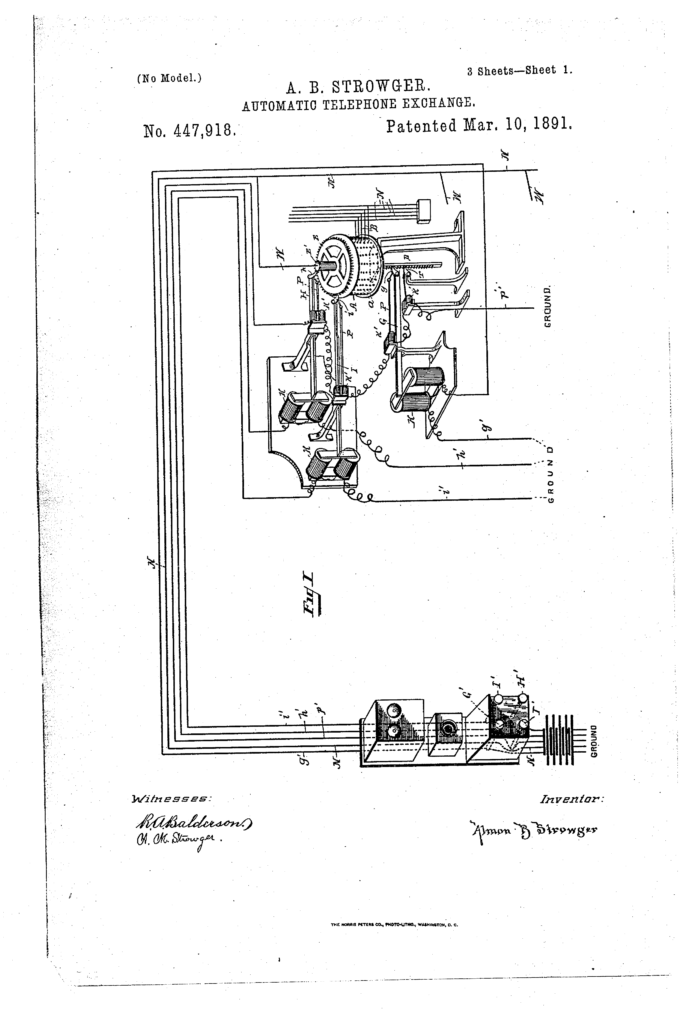In the late 19th century, the telecommunication industry experienced a significant shift with the invention of the automatic telephone switching system by Almon Strowger, an undertaker from Kansas City, Missouri.
The Automatic Telephone Switching System

Above is an image of the front page of the patent issued to Mr. Strowger (you can read the whole patent here). His invention (like many), solved a particular problem he faced with his own phone system.
Strowger's invention of a new telephone switching system was driven by his frustration over human telephone operators misdirecting his customers' calls.
His solution?
A mechanism that, once in place, revolutionized the telephone industry and remained a central component of telephone networks worldwide for much of the twentieth century.
Strowger's device was unique and innovative. It featured buttons that a caller tapped to signal the desired number to a central switch. At the switch, a rotating arm moved the caller's line until it connected with the desired number. Strowger designed each unit to handle a large number of lines and to be easily scalable without increasing complexity. This invention laid the foundation for the automation of telephony, setting the stage for the developments that would follow in the 20th century.
Auto-Dialers
Fast forward to the 1980s, and a number of significant developments took place in the area of auto-dialers. First, dialing systems were introduced which automatically dialed calls on behalf of call center agents. These autodialers (also called “call origination management systems”) placed one call for each available agent.
These early autodialers worked much like they do today. They automatically dialed clients, listened for the call result (i.e., ringing, busy signal, answer, no answer, etc.), and when a call resulted in an answer, they automatically transferred the call to an available operator.
But companies wanted more efficiency. They wanted to maximize agent productivity time.
The Invention of the Predictive Dialer
In the late 1980s, a significant development took place with the introduction of predictive dialing techniques by InfoLogix Incorporated's Douglas A. Samuelson. Samuelson was granted US Patent 4,858,120 for his predictive dialing system (aka his “System for regulating arrivals of customers to servers”) which sought to address some of the inefficiencies of previous dialing systems.
In Samuelson's predictive dialer, he used mathematical calculations to predict when a call should be made (based on a prediction of whether the call would be answered as well as whether an agent would be available to answer the call). This was the first true “predictive” dialing approach (as opposed to autodialers which did not take into account these predictions of answer / available).
As discussed in Samuelson's patent, “the system may begin more than one process per server if each process is unlikely to require a server; for example, the call origination management system may dial more than one line for each server expected to be available, to reflect the likelihood of not getting answers on every dialing attempt.”
Of course, the first predictive dialing approach needed some tweaks to make it better. One big innovation was the concept of call pacing.
Call Pacing
In 1989, International Telesystems Corp. invented a “call pacing” system. The system used an adaptive call pacing algorithm based on a statistical analysis of the times of calls. The algorithm was used to determine when and how many calls to dial in a call origination management system. This pacing algorithm determines the number of calls to dial as an inverse function of the mean time of all calls and the standard deviation multiplied by a first constant. You can read the patent here.
This new call pacing approach was an improvement to the original predictive dialing system invented by Samuelson. In practice, the Samuelson approach was found to work very well for some applications while it worked poorly in others. In some cases, the efficiency of the predictive dialer was high and the number of nuisance calls acceptably low, while in other cases, the efficiency was either low or the number of nuisance calls were unacceptably high or both.
The call pacing approach helped improve this efficiency.
Call pacing innovations have continued, with other systems taking the approach of recalculating the number of calls to dial periodically (e.g. every two seconds) based on anticipated operator availability. In some systems, the determined number of calls are dialed, subject to a limiting function. Calls in progress may be interrupted in a short time slot just prior to first ring if the number of operators available to respond to an answered call falls below a predetermined percentage of the total number of system operators.
Summary
The concepts of predictive dialing and auto-dialers have been around for several decades. The basic concepts remain the same: autodialers automatically dial outbound calls for agents, and predictive dialers are autodialers that involve some predictive math to dial more than one call per agent. Current autodialers and predictive dialers continue to use these basic concepts from almost forty years ago

